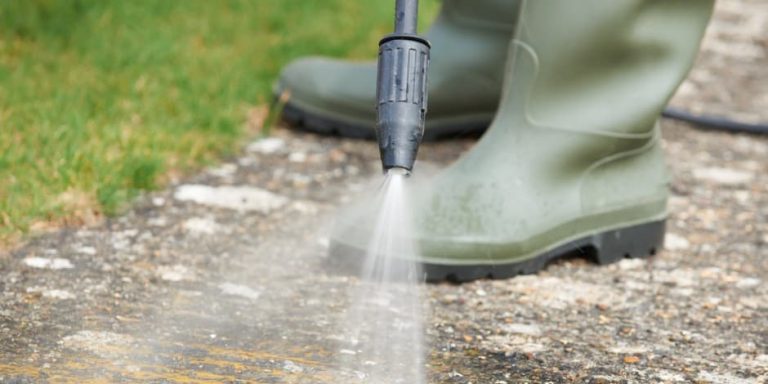
Historic landmarks, century-old buildings, delicate stonework, and time-worn monuments all share one thing in common—they can’t be cleaned like just any surface. While power washing is a fast and effective method for removing dirt, mold, graffiti, or pollution stains, using it on delicate or historically significant structures without proper care can result in irreversible damage.
In this article, we’ll explore how to clean fragile or historic surfaces using sustainable, eco-friendly power washing methods—preserving both our cultural heritage and the environment. 🧼🏛️
🕰️ Why Traditional Power Washing Can Be Harmful
Power washing typically relies on high-pressure water jets—often over 2,000 PSI (pounds per square inch)—combined with strong chemicals to break down contaminants. While that’s effective on concrete or vinyl siding, fragile materials like sandstone, limestone, or old brick can be eroded, cracked, or discolored.
Add in bleach or acid-based solutions, and you risk:
- Damaging historic patinas
- Killing nearby plant life
- Polluting storm drains with chemical runoff
- Stripping eco-safe coatings or finishes
- Violating local preservation or environmental laws
One careless job could erase decades—or centuries—of history. 🧱💔
🧭 What Counts as a “Delicate” Structure?
Delicate or historically significant structures might include:
- Historic homes or buildings (pre-1940s)
- Cemeteries, mausoleums, or gravestones
- War memorials and statues
- Libraries, museums, and places of worship
- Worn natural stone, soft brick, stucco, or wood
- Adobe walls or lime mortar constructions
These materials were built long before modern waterproofing and are highly susceptible to damage from high-pressure water or chemical exposure.
♻️ Principles of Sustainable Cleaning for Historic Surfaces
1. Use the Least Aggressive Method First
Sustainability and preservation go hand in hand. Begin with:
- Gentle rinsing
- Soft brushes
- Eco-friendly soaps
- Steam or low-pressure hot water
Escalate only when necessary. The goal is minimal impact, maximum preservation.
2. Use Low-Pressure “Soft Washing” Techniques
Soft washing operates below 500 PSI and relies on:
- Extended dwell times
- Biodegradable detergents
- Brushes or cloths for mechanical agitation
This reduces erosion and keeps surfaces intact—while still cleaning effectively. It’s ideal for:
- Fragile stucco or plaster
- Ornamental stone
- Wood trim and siding
Browse Amazon Here For Soft Washing Equipment And Accessories
3. Avoid Harsh Chemicals
Steer clear of:
- Chlorine bleach (corrosive to stone and metals)
- Acid-based cleaners (etch and discolor soft stone)
- Solvent-based degreasers (harmful to paints and seals)
Instead, use:
- pH-neutral cleaners
- Biological enzymes
- Plant-based degreasers
- Steam cleaning (with distilled water)
🧪 Always spot test in a hidden area first!
🌿 Environmental Protection Measures
When cleaning historic or delicate structures, environmental concerns go beyond protecting the structure alone—you also need to consider:
🏞️ 1. Protect Nearby Landscaping
Set up barriers or tarps to shield trees, flowers, and lawns from chemicals or runoff.
🌊 2. Contain Runoff
Use portable berms, gutter blockers, or reclaim systems to prevent runoff from entering storm drains or groundwater.
🐝 3. Avoid Disruption to Wildlife
Historic structures often house birds, bats, or pollinators. Schedule cleanings outside of nesting seasons, and monitor for protected species.
🛠️ Tools of the Trade for Eco-Friendly Historic Cleaning
| Tool/Technique | Why It’s Sustainable |
|---|---|
| Low-pressure sprayers | Minimizes erosion risk |
| Steam cleaning | Uses heat instead of chemicals |
| Enzyme-based cleaners | Breaks down organics safely |
| Manual brushing | Preserves detail while reducing runoff |
| Water reclaim systems | Prevents pollution of surrounding areas |
💡 Bonus tip: Use distilled water to prevent mineral deposits or spotting on delicate surfaces.
🧾 Legal & Regulatory Considerations
Cleaning historic buildings often requires:
- Permits from preservation societies
- Review by local heritage boards
- Compliance with environmental regulations (especially if using water near public land)
Failure to follow these guidelines could result in:
- Fines
- Damaged reputation
- Loss of contractor eligibility for public work
🧠 Always check with local agencies before beginning work.
🌍 Why Sustainable Practices Matter Here
Historic sites are cultural treasures—but they’re also often located in environmentally sensitive areas like old downtowns, parks, cemeteries, or waterfronts.
Using traditional harsh cleaners or blasting away grime may solve a short-term aesthetic problem but create long-term environmental ones, including:
- Water pollution
- Soil degradation
- Air quality reduction
- Wildlife habitat disruption
Preservation doesn’t just mean saving stone—it means respecting the environment around it. 🌱🧱
📖 Case Study: Restoring a Historic Library the Green Way
A mid-1800s sandstone library in New England was covered in decades of grime. Rather than using high-pressure jets, the cleaning team:
- Used a 300 PSI sprayer
- Applied a biological algae remover
- Steam-rinsed surfaces with filtered water
- Protected hedges and flowerbeds with cloth barriers
- Used drain socks and reclaimed all wastewater
The result? A beautifully restored facade—and zero environmental violations. ✅
🧠 Final Thoughts
Cleaning historic and delicate structures isn’t just about appearance—it’s about stewardship. These buildings are one-of-a-kind, and the responsibility of preserving them falls on everyone involved, from contractors to property owners.
By using soft washing methods, biodegradable products, runoff containment, and a thoughtful approach, you can maintain their beauty without compromising the integrity of the environment.
Let’s clean history with respect. 💚🏛️
Browse Amazon Here For Soft Washing Equipment And Accessories






